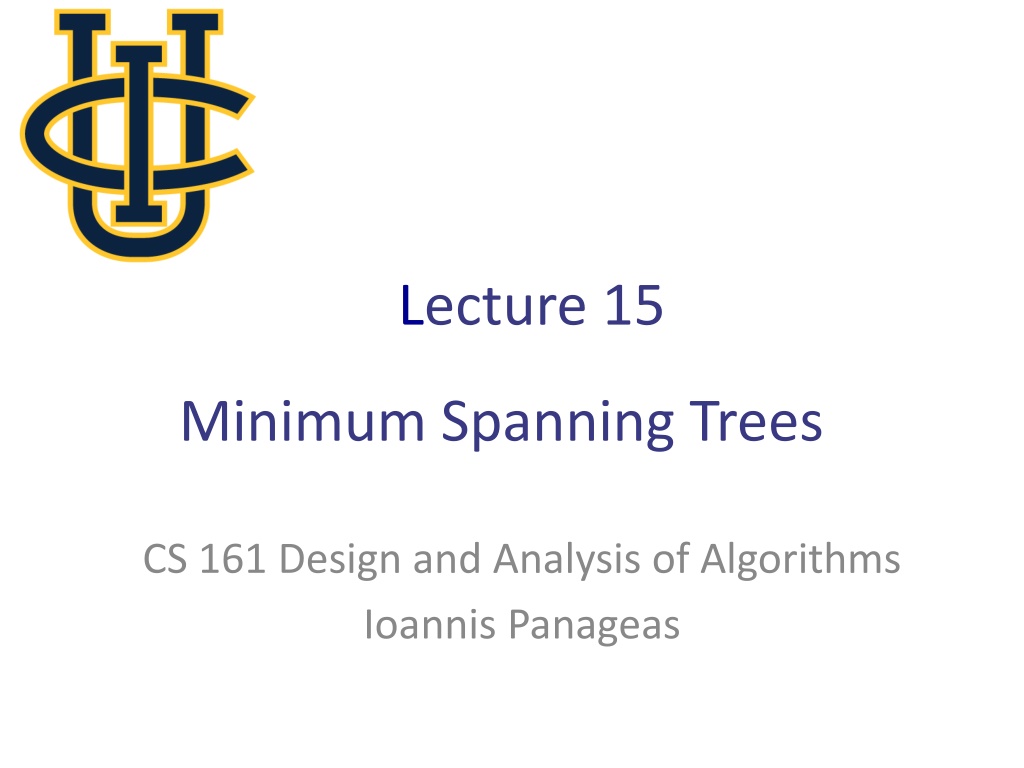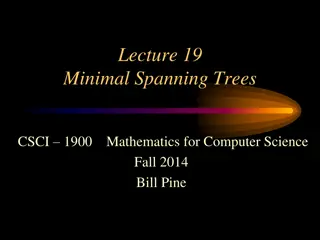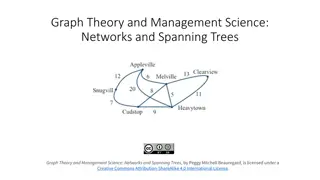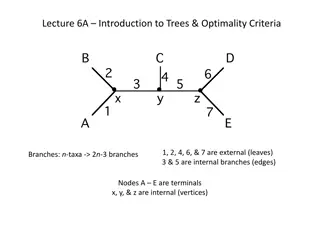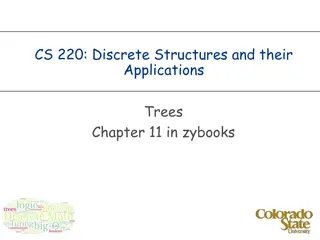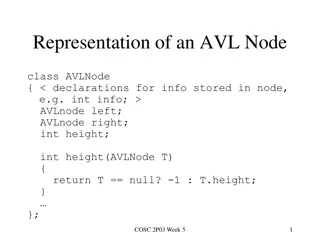Understanding Minimum Spanning Trees in Graph Theory
Exploring the concept of minimum spanning trees in undirected, weighted graphs. A spanning tree is a connected acyclic subgraph that includes all vertices of the original graph. The Minimum Spanning Tree (MST) problem involves finding the tree with the smallest total edge weight. The cycle property of MSTs is also discussed, highlighting the relationship between edges in the tree and potential cycles. Examples and visual representations further elucidate these fundamental graph theory concepts.
Download Presentation

Please find below an Image/Link to download the presentation.
The content on the website is provided AS IS for your information and personal use only. It may not be sold, licensed, or shared on other websites without obtaining consent from the author. Download presentation by click this link. If you encounter any issues during the download, it is possible that the publisher has removed the file from their server.
E N D
Presentation Transcript
Lecture 15 Minimum Spanning Trees CS 161 Design and Analysis of Algorithms Ioannis Panageas
Spanning Tree Definition: We are given an undirected, weighted graph ?. A spanning tree of ? is a connected acyclic (tree) subgraph of ?that includes all the vertices of ?(spanning). OAK 10 1 MIA 6 LA 7 9 3 BOS NYC 4 5 8 2 DC ATL Design and Analysis of Algorithms
Spanning Tree Definition: We are given an undirected, weighted graph ?. A spanning tree of ? is a connected acyclic (tree) subgraph of ?that includes all the vertices of ?(spanning). OAK 10 1 MIA 6 LA 7 9 3 BOS NYC 4 5 8 2 DC ATL Design and Analysis of Algorithms
Spanning Tree Definition: We are given an undirected, weighted graph ?. A spanning tree of ? is a connected acyclic (tree) subgraph of ?that includes all the vertices of ?(spanning). OAK 10 1 MIA 6 LA 7 9 3 BOS NYC 4 5 8 2 DC ATL Design and Analysis of Algorithms
Spanning Tree Definition: We are given an undirected, weighted graph ?. A spanning tree of ? is a connected acyclic (tree) subgraph of ?that includes all the vertices of ?(spanning). OAK 10 1 MIA 6 LA 7 9 3 BOS Not a spanning tree. It is not spanning (MIA). NYC 4 5 8 2 DC ATL Design and Analysis of Algorithms
Spanning Tree Definition: We are given an undirected, weighted graph ?. A spanning tree of ? is a connected acyclic (tree) subgraph of ?that includes all the vertices of ?(spanning). OAK 10 1 MIA 6 LA 7 9 3 BOS Not a spanning tree. It is not a tree (cycle). NYC 4 5 8 2 DC ATL Design and Analysis of Algorithms
Minimum Spanning Tree Problem: We are given an undirected, weighted graph ?, find the minimum spanning tree (MST). OAK 10 1 MIA 6 LA 7 9 3 BOS NYC 4 5 8 2 DC ATL Design and Analysis of Algorithms
Minimum Spanning Tree Cycle Property Let ? be a minimum spanning tree of a weighted graph ?. Let ? be an edge of ? that is not in ?and ? let be the cycle formed by ? with ?. OAK 10 1 MIA 6 LA 7 9 3 BOS It holds that: For every edge ? of ?, ???? ? ? ???? ? ? . NYC 4 5 8 2 DC ATL Design and Analysis of Algorithms
Minimum Spanning Tree Cycle Property Let ? be a minimum spanning tree of a weighted graph ?. Let ? be an edge of ? that is not in ?and ? let be the cycle formed by ? with ?. OAK 10 1 MIA 6 LA 7 9 3 BOS It holds that: For every edge ? of ?, ???? ? ? ???? ? ? . NYC 4 5 8 2 ? Example 1: Cycle LA, DC, NYC, OAK ? ? = 8 1,6,4 (rest of weights) DC ATL Design and Analysis of Algorithms
Minimum Spanning Tree Cycle Property Let ? be a minimum spanning tree of a weighted graph ?. Let ? be an edge of ? that is not in ?and ? let be the cycle formed by ? with ?. OAK 10 1 MIA 6 LA 7 9 3 BOS It holds that: For every edge ? of ?, ???? ? ? ???? ? ? . NYC 4 5 8 2 Example 2: Cycle BOS, ATL, NYC ? ? = 5 2,3 (rest of weights) DC ATL Design and Analysis of Algorithms
Minimum Spanning Tree Cycle Property For the sake of contradiction: 8 f 4 9 6 2 3 e Assume there exist ?,? so that 7 8 7 ???? ? ? > ???? ?(?) Replacing ? with ? yields a better spanning tree 8 f 4 9 6 2 3 e 7 8 7 Design and Analysis of Algorithms
Kruskals Algorithm for MSTs Idea 1: Greedy approach. Consider the edges from smaller weight to larger. Include each edge in the current solution as long as it does not create a cycle, otherwise discard it. 8 B G 4 E 5 9 F 1 6 3 C 11 7 2 H D 12 10 A Design and Analysis of Algorithms
Kruskals Algorithm for MSTs Idea 1: Greedy approach. Consider the edges from smaller weight to larger. Include each edge in the current solution as long as it does not create a cycle, otherwise discard it. 8 B G 4 E 5 9 F 1 6 3 C 11 7 2 H D 12 10 A Design and Analysis of Algorithms
Kruskals Algorithm for MSTs Idea 1: Greedy approach. Consider the edges from smaller weight to larger. Include each edge in the current solution as long as it does not create a cycle, otherwise discard it. 8 B G 4 E 5 9 F 1 6 3 C 11 7 2 H D 12 10 A Design and Analysis of Algorithms
Kruskals Algorithm for MSTs Idea 1: Greedy approach. Consider the edges from smaller weight to larger. Include each edge in the current solution as long as it does not create a cycle, otherwise discard it. 8 B G 4 E 5 9 F 1 6 3 C 11 7 2 H D 12 10 A Design and Analysis of Algorithms
Kruskals Algorithm for MSTs Idea 1: Greedy approach. Consider the edges from smaller weight to larger. Include each edge in the current solution as long as it does not create a cycle, otherwise discard it. 8 B G 4 E 5 9 F 1 6 3 C 11 7 2 H D 12 10 A Design and Analysis of Algorithms
Kruskals Algorithm for MSTs Idea 1: Greedy approach. Consider the edges from smaller weight to larger. Include each edge in the current solution as long as it does not create a cycle, otherwise discard it. 8 B G 4 E 5 9 F 1 6 3 C 11 7 2 H D 12 10 A Design and Analysis of Algorithms
Kruskals Algorithm for MSTs Idea 1: Greedy approach. Consider the edges from smaller weight to larger. Include each edge in the current solution as long as it does not create a cycle, otherwise discard it. 8 B G 4 E 5 9 F 1 6 3 C 11 7 2 H D 12 10 A Design and Analysis of Algorithms
Kruskals Algorithm for MSTs Idea 1: Greedy approach. Consider the edges from smaller weight to larger. Include each edge in the current solution as long as it does not create a cycle, otherwise discard it. 8 B G 4 E 5 9 F 1 6 3 C 11 7 2 H D 12 10 A Design and Analysis of Algorithms
Kruskals Algorithm for MSTs Idea 1: Greedy approach. Consider the edges from smaller weight to larger. Include each edge in the current solution as long as it does not create a cycle, otherwise discard it. 8 B G 4 E 5 9 F 1 6 3 C 11 7 2 H D 12 10 A Design and Analysis of Algorithms
Kruskals Algorithm for MSTs Idea 1: Greedy approach. Consider the edges from smaller weight to larger. Include each edge in the current solution as long as it does not create a cycle, otherwise discard it. 8 B G 4 E 5 9 F 1 6 3 C 11 7 2 H D 12 10 A Design and Analysis of Algorithms
Kruskals Algorithm for MSTs Idea 1: Greedy approach. Consider the edges from smaller weight to larger. Include each edge in the current solution as long as it does not create a cycle, otherwise discard it. 8 B G 4 E 5 9 F 1 6 3 C 11 7 2 H D 12 10 A Design and Analysis of Algorithms
Kruskals Algorithm for MSTs Idea 1: Greedy approach. Consider the edges from smaller weight to larger. Include each edge in the current solution as long as it does not create a cycle, otherwise discard it. 8 B G 4 E 5 9 F 1 6 3 C 11 7 2 H D 12 10 A Design and Analysis of Algorithms
Kruskals Algorithm for MSTs Idea 1: Greedy approach. Consider the edges from smaller weight to larger. Include each edge in the current solution as long as it does not create a cycle, otherwise discard it. 8 B G 4 E 5 9 F 1 6 3 C 11 7 2 H D 12 10 A Design and Analysis of Algorithms
Kruskals Algorithm for MSTs Why Kruskal s algo works: General argument. Suppose there is a better solution. Assume the ? edges of ? are ordered in increasing order of weights, i.e., w1 ?2 ??. ? has also ? vertices. Let ?1, ,?? 1 be the weight values of the edges in increasing order of the minimum spanning tree ? . Let ?1, ,?? 1be the weight values of the edges in increasing order of Kruskal s spanning tree ?. Design and Analysis of Algorithms
Kruskals Algorithm for MSTs Why Kruskal s algo works: General argument. Suppose there is a better solution. Assume the ? edges of ? are ordered in increasing order of weights, i.e., w1 ?2 ??. ? has also ? vertices. Let ?1, ,?? 1 be the weight values of the edges in increasing order of the minimum spanning tree ? . Let ?1, ,?? 1be the weight values of the edges in increasing order of Kruskal s spanning tree ?. There is an index ?, so that ?? < ??. We add edge with value ??in ? , we create a cycle ?. Design and Analysis of Algorithms
Kruskals Algorithm for MSTs Why Kruskal s algo works: General argument. Suppose there is a better solution. Assume the ? edges of ? are ordered in increasing order of weights, i.e., w1 ?2 ??. ? has also ? vertices. Let ?1, ,?? 1 be the weight values of the edges in increasing order of the minimum spanning tree ? . Let ?1, ,?? 1be the weight values of the edges in increasing order of Kruskal s spanning tree ?. There is an index ?, so that ?? < ??. We add edge with value ??in ? , we create a cycle ?. If ?? is in ?, we remove it and create a spanning tree smaller than T (contradiction). Design and Analysis of Algorithms
Kruskals Algorithm for MSTs Why Kruskal s algo works: General argument. Suppose there is a better solution. Assume the ? edges of ? are ordered in increasing order of weights, i.e., w1 ?2 ??. ? has also ? vertices. Let ?1, ,?? 1 be the weight values of the edges in increasing order of the minimum spanning tree ? . Let ?1, ,?? 1be the weight values of the edges in increasing order of Kruskal s spanning tree ?. There is an index ?, so that ?? < ??. We add edge with value ??in ? , we create a cycle ?. If ?? is in ?, we remove it and create a spanning tree smaller than T (contradiction). If ?? not in ?, by cycle property, ?? is the largest value from edges in C. Kruskal would not have chosen ?? (contradiction). Design and Analysis of Algorithms
Prims Algorithm for MSTs Idea 2: Similar to Dijkstra s algorithm. We pick an arbitrary vertex ?. We build the tree by adding one new vertex at a time. Each vertex ? has label ? ? smallest weight of an edge connecting ? to a vertex in the built tree. At each step: We add to the current tree the vertex ? with the smallest ?[?] and the corresponding incident to ? edge. We update the labels of the vertices adjacent to ?. Design and Analysis of Algorithms
Prims Algorithm for MSTs Idea 2: Similar to Dijkstra s algorithm. We pick an arbitrary vertex ?. At each step: We add to the current tree the vertex ? with the smallest ?[?] and the corresponding incident to ? edge. We update the labels of the vertices adjacent to ?. 8 B G 4 E 5 9 F 1 6 3 C 11 7 2 H D 12 10 A Design and Analysis of Algorithms
Prims Algorithm for MSTs Idea 2: Similar to Dijkstra s algorithm. We pick an arbitrary vertex ?. At each step: We add to the current tree the vertex ? with the smallest ?[?] and the corresponding incident to ? edge. We update the labels of the vertices adjacent to ?. 8 B G 4 E 5 9 F 1 6 3 C 11 7 2 H D 12 10 A Design and Analysis of Algorithms
Prims Algorithm for MSTs Idea 2: Similar to Dijkstra s algorithm. We pick an arbitrary vertex ?. At each step: We add to the current tree the vertex ? with the smallest ?[?] and the corresponding incident to ? edge. We update the labels of the vertices adjacent to ?. 8 B G 4 E 5 9 F 1 6 3 C 11 7 2 H D 12 10 A Design and Analysis of Algorithms
Prims Algorithm for MSTs Idea 2: Similar to Dijkstra s algorithm. We pick an arbitrary vertex ?. At each step: We add to the current tree the vertex ? with the smallest ?[?] and the corresponding incident to ? edge. We update the labels of the vertices adjacent to ?. 8 B G 4 E 5 9 F 1 6 3 C 11 7 2 H D 12 10 A Design and Analysis of Algorithms
Prims Algorithm for MSTs Idea 2: Similar to Dijkstra s algorithm. We pick an arbitrary vertex ?. At each step: We add to the current tree the vertex ? with the smallest ?[?] and the corresponding incident to ? edge. We update the labels of the vertices adjacent to ?. 8 B G 4 E 5 9 F 1 6 3 C 11 7 2 H D 12 10 A Design and Analysis of Algorithms
Prims Algorithm for MSTs Idea 2: Similar to Dijkstra s algorithm. We pick an arbitrary vertex ?. At each step: We add to the current tree the vertex ? with the smallest ?[?] and the corresponding incident to ? edge. We update the labels of the vertices adjacent to ?. 8 B G 4 E 5 9 F 1 6 3 C 11 7 2 H D 12 10 A Design and Analysis of Algorithms
Prims Algorithm for MSTs Idea 2: Similar to Dijkstra s algorithm. We pick an arbitrary vertex ?. At each step: We add to the current tree the vertex ? with the smallest ?[?] and the corresponding incident to ? edge. We update the labels of the vertices adjacent to ?. 8 B G 4 E 5 9 F 1 6 3 C 11 7 2 H D 12 10 A Design and Analysis of Algorithms
Prims Algorithm for MSTs Idea 2: Similar to Dijkstra s algorithm. We pick an arbitrary vertex ?. At each step: We add to the current tree the vertex ? with the smallest ?[?] and the corresponding incident to ? edge. We update the labels of the vertices adjacent to ?. 8 B G 4 E 5 9 F 1 6 3 C 11 7 2 H D 12 10 A Design and Analysis of Algorithms
Prims Algorithm for MSTs Idea 2: Similar to Dijkstra s algorithm. We pick an arbitrary vertex ?. At each step: We add to the current tree the vertex ? with the smallest ?[?] and the corresponding incident to ? edge. We update the labels of the vertices adjacent to ?. 8 B G 4 E 5 9 F 1 6 3 C 11 7 2 H D 12 10 A Design and Analysis of Algorithms
Prims Algorithm for MSTs Pseudocode: Starting vertex Initialization Relaxation Design and Analysis of Algorithms
Prims Algorithm for MSTs Pseudocode: Starting vertex Initialization Relaxation Design and Analysis of Algorithms
Prims Algorithm for MSTs Pseudocode: Starting vertex Initialization Relaxation ?( ??) Design and Analysis of Algorithms
Prims Algorithm for MSTs Pseudocode: Starting vertex Initialization Relaxation Design and Analysis of Algorithms
